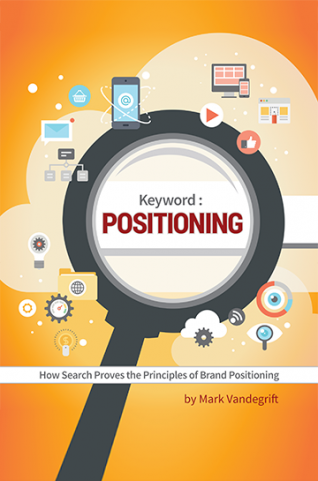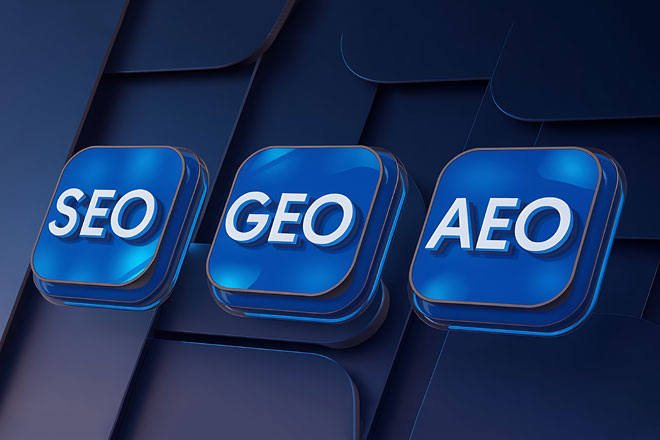As AI continues to hold the attention of marketers, some new terms have surfaced for which we receive many inquiries: AEO and GEO. What are AEO and GEO and how do they relate to AI? What are the best marketing strategies for AEO and GEO? How do these differ from what we’ve been doing with our SEO efforts? These and many other related questions are topic de jour in many of our client discussions. The good news is, if you’ve followed our guidance for SEO through the years, adjusting for AEO and GEO will be seamless. We wrote about Marketing to AI in April of this year, so consider this an expansion on that topic. You may wish to read that article first to get caught up on the conversation.
But first, for those unaware of AEO or GEO, or who don’t understand how they might impact marketing strategies, let’s define the terms and how they impact a marketer’s initiatives.
AEO
AEO stands for Answer Engine Optimization. AEO is designed to answer questions that users pose in either traditional search engines such as Google and Bing or in AI search engines such as Perplexity AI and ChatGPT Search, for which a direct answer is appropriate. These questions typically require a succinct answer where the user does not intend to take an immediate click action to dive deeper. For example, “What is the actual size of a 2x4?” Or, “What is the difference between AEO and GEO?” While most assume these answers are crafted by AI, the better way to understand it is that these answers are curated from sources that AI considers most authoritative.
GEO
GEO stands for Generative Engine Optimization. GEO expands on the concept of AEO by providing more extensively sourced content which may result in a deeper inquiry by the user. Think of Generative EO as semantically proper “AI-generated” answers that result from the content of a variety of authoritative sources. The goal, and one of the best marketing strategies for AEO and GEO, is to provide content that traditional or AI search engines consider authoritative. The best strategy for GEO optimization is at the heart of the “Marketing to AI” article noted above. The goal? Get your content to be cited as one of the sources to search queries/questions asked within these search engines.
Five of the Best Marketing Strategies for AEO and GEO:
- Think like your customer
- Write UNIQUE content
- Continue to sculpt for SEO
- Optimize for zero-click answers (AEO)
- Optimize as a source to be cited with intent-to-click or intent-to-purchase inquiries (GEO)
Let’s do a deeper dive on each of these.
Think Like Your Customer
This advice is good advice regardless of whether you’re writing for a search engine or writing for a billboard, print ad, social post, or pretty much any marketing. However, in this context, you need to spend sufficient time in the various search engines to understand how the results are assembled from various sources. Google’s Gemini doesn’t work like Perplexity AI, and Bing doesn’t return results the same way as Yahoo!. So, you have to put on the mind of your target audience and do some investigative searching. Spend time on Google. Spend time in Perplexity AI. Play around with various search terms and questions to learn the types of results each is returning in its various results pages. Many of you want a shortcut and we get that, but nothing performs better than living in the search engines for a while to understand how each is assembling its results. Only then will you be able to craft content that will be attractive to them.
Write Unique Content
We could have placed this best marketing strategy for AEO and GEO first, because we will continue to shout it until we are blue in the face. You CANNOT use AI-generated content and expect to land well in the AEO and GEO space. The search engines are seeking unique content, not content that was assembled by citing other sources. Think about it. You use AI-generated copy that comes from other sources. Why would AI turn around and cite itself when it’s using third-party sources?
We continue to gain new clients because they show up wondering why their content marketing is failing. The first place we start is by scanning their content to see if it’s AI-generated. Without exception, it hits at 100% AI. Their answer? Well, our other agency told us to just start churning out articles using ChatGPT. That’s the worst advice ever. If your current agency ever suggests that to you, find another agency (we happen to know a good one!).
Besides, if you can’t write unique content, then we at this agency will wonder if you’re marketing your position at all. Positioning = differentiation = unique. Don’t copy everyone else. Stand out and apart from your competition.
Continue to Sculpt for SEO
Nothing has changed in this regard. All the principles of SEO still apply with one exception: Google wants MORE content. Don’t be afraid to bulk up each page of your site with 700+ words. Google assumes if you can write 700+ words about your unique topics on your website (e.g., products, services, applications, markets, etc.), then you must know your stuff. It’s the stuff of an expert, worthy of being cited. And don’t forget to properly sculpt your images, graphics, illustrations, diagrams, videos, and other content. You will not know all the ways that search engines will use your content in their search engine results pages (SERPs), so keep following the advice and course we’ve laid out if you’ve consulted with us before on SEO. If you need SEO direction and aren’t familiar with our SEO methodologies, reach out today and we can share more.
Optimize for Zero-Click Answers (AEO)
If you simply want brand awareness and exposure as an expert, AEO is perfect for you. Just know that you won’t get a lot of clicks out of it. This is a long-game play to build brand equity. To optimize for AEO, make sure this type of content is concise, direct answers to questions. FAQs and How-to content are great strategies for AEO, and they don’t just have to be in the form of copy. You can create videos and graphics, too. Just remember to keep the answers short, with lists, bullets, and clear headlines and sufficiently alt tag any graphics and transcript all videos. A good example of AEO content is like the list above under the “five of the best strategies for AEO and GEO” section. AEO is most commonly used on mobile and voice queries, so don’t expect your brand to receive exposure every time. The top rule is to keep the answers to around 25-60 words, but don’t shortchange them.
Optimize as a Source to be Cited With Intent-to-Click or Intent-to-Purchase Inquiries (GEO)
If being cited as a source is your goal, then GEO should be your focus. The best marketing strategy for GEO is to write more similarly to a white paper. Answers can be longer, but should be annotated with citations and facts. Accompanying videos, diagrams, illustrations, graphs, charts, tables, and other descriptive graphics are valuable. Use well-organized schema (aka structure) that AI can parse easily. An example of well-structured content is found within these five sections that expand on the original five-point list. Each section is clearly sub-headed and the answers are approximately the same length. The challenge with GEO is that source and citation formats are still evolving and click-thrus can be hit-or-miss. Many users miss the citations because they are indicated in a very subtle way by most traditional and AI search engines. Google’s Gemini is one of the most obvious, where most commonly, each paragraph has a light gray link icon at the end of it. If you click on that icon, the sources appear to the right (or in a pop-up/modal window on mobile).
Where Will This End?
Good question. AI is still in its infancy. But make no mistake: unique, proprietary, copious, reader-friendly, persuasive content is still king. All AI can do at this time is scrape content from around the inter-webs and return it to you quickly and semantically. It’s not either-or, but both-and. SEO and AEO and GEO and whatever-comes-next-EO. If this really intrigues you, then join the conversation on Reddit.
If this causes your mind to blow, then contact Innis Maggiore today. We live in this world and realize it’s not getting easier. AI is supposed to make the world easier, but we’ve found it has confused marketers more than it has helped thus far. We’re sure it will one day “get there,” but that day is not today.



